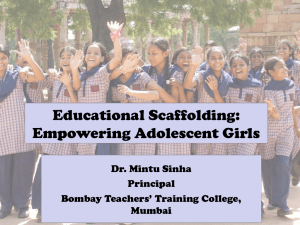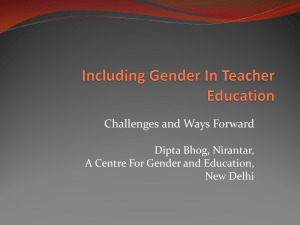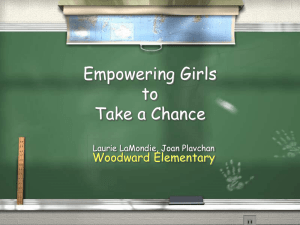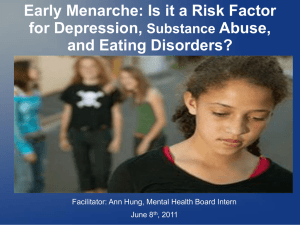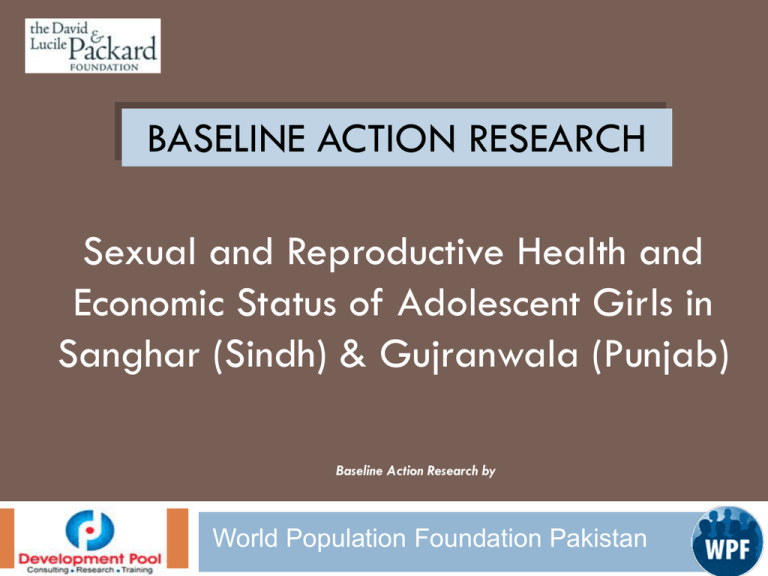
BASELINE ACTION RESEARCH
Sexual and Reproductive Health and
Economic Status of Adolescent Girls in
Sanghar (Sindh) & Gujranwala (Punjab)
Baseline Action Research by
World Population Foundation Pakistan
Why was the Study done?
2
To determine a baseline for knowledge,
attitude and practice of Sexual and
Reproductive Health and Economic indicators
in the adolescent girls of two target districts
of Gujranwala and Sanghar, and
To assess the demand for reliable Sexual
and Reproductive Health (SRH) knowledge
and services among school-going and nonschool adolescent girls
Methods
3
Policy
and literature review
KAP Survey of school going and non-school
going adolescent girls
Focus Group Discussions (FGDs)
Collection of School Data Sheets
In-depth interviews with district education and
health authorities
Interviews with School Management
Data analysis and report
District Fact Sheet
4
Population (1998)
Population (2010, est.)
Urban Population
Growth rate (p.a.)
Population Density (per square kilometer)
Reproductive Health Centers
Basic Health Units
Fertility Rate
Family/Household Size
Contraceptive prevalence rate
Number of registered medical practitioners
Literacy Rate
Number of primary schools for girls
Number of high schools for girls
Gujranwala
3,370,000
4,308,905
50.17%
2.80%
172
78
53
7
7.6
32%
285
60%
5,283
85
Source: Population Welfare Department, Government of Sindh, EDO (Health) and EDO (Education) Gujranwala
Participation Summary
5
Geographic location: Gujranwala district
Survey Respondents
Non-School Going Girls
Total
Gujranwala
1519
997
76
50
Headmistresses/Principals
interviewed
Primary Stakeholders: FGDs
55
35
160
74
In-depth Interviews (District
Education & Health Officials)
16
8
DATA ANALYSIS
INDICATORS
World Population Foundation Pakistan
Knowledge in Adolescent Girls About Specific STDs
10
Status of Respondents in terms
of School Going
Know_
STDs_Spec
Knowledge
in
Adolescent
Girls about
Specific
STDs
Total
0 Not
School
Going
1 School
Going
Total
1 Hepatitis
B/C
10.3%
17.8%
17.4%
2 HIV-AIDS
20.7%
42.9%
41.7%
3 Hepatitis
B/C & HIVAIDS
8.6%
5.3%
5.5%
4 STIs
8.6%
11.4%
11.2%
5 No
Knowledge
51.7%
22.7%
24.3%
100.0%
100.0%
100.0%
Stakeholders’ Perspective
Knowledge in Adolescent Girls About Specific STDs
11
Adolescent
girls are often reluctant to share
their adolescent issues even with lady health
visitors or workers.
LHVs and LHWs can play important and
effective role to raise awareness among
adolescent girls about STDs
Knowledge in Adolescent Girls About Prevention from STDs
12
Status of Respondents in terms
of School Going
Know_Prev
Knowledge in
Adolescent
Girls about
Prevention
from STDs
Total
0 No
1 Yes
0 Not
School
Going
1 School
Going
Total
62.1%
85.6%
84.3%
37.9%
14.4%
15.7%
100.0%
100.0%
100.0%
Guidance Received by Adolescent Girls over Body Changes
13
SStatus of Respondents in
terms of School Going
Know_Guidance
Guidance
received by
Adolescent Girls
over Body
Changes
Total
0 No
1 Yes
0 Not
School
Going
1 School
Going
Total
58.6%
22.0%
24.0%
41.4%
78.0%
76.0%
100.0%
100.0%
100.0%
S t a k e h o l d e r s ’ Pe r s p e c t i ve
(Guidance Received by Adolescent Girls over Body Changes)
14
Mothers
and teachers can serve as important
sources of guidance on body changes among
the adolescent girls.
Discussion on body changes, particularly in
rural areas, is considered as in indecent topic
of discussion.
By and large, girls are not provided any
guidance on how to take care of them upon
natural body changes
Desire Among Adolescent Girls to Learn about STDs
15
Status of Respondents in
terms of School Going
Know_Learn
Desire among
Adolescent
Girls to learn
about STDs
Total
0 No
0 Not
School
Going
1
School
Going
Total
15.5%
15.7%
15.7%
84.5%
84.3%
84.3%
100.0%
100.0%
100.0%
1 Yes
S t a k e h o l d e r s ’ Pe r s p e c t i ve
(Desire Among Adolescent Girls to Learn about STDs)
16
Besides
family planning, there is a dire need
to raise awareness among adolescent girls
about STDs and its link with their general and
reproductive health.
In urban areas, women who experienced
STDs wish to guide their daughters, but they
have no means of knowing about STDs.
What Should be Ideal Age of Marriage for men?
17
Status of Respondents in
terms of School Going
Know_Ideal
_age_men
"What
should be
ideal age of
marriage
for men?"
Total
0 Not
School
Going
1
School
Going
Total
1. Up till
20 years
14.8%
10.6%
10.8%
2. 21-25
years
63.0%
64.4%
64.3%
3. 26-29
years
16.7%
15.4%
15.5%
4 .29
years
and
above
5.6%
9.6%
9.4%
100.0%
100.0% 100.0%
What Should be Ideal Age of Marriage for women?
18
Status of Respondents in
terms of School Going
Know_Ideal_
age_women
"What
should be
ideal age of
marriage for
women?"
Total
0 Not
School
Going
1
School
Going
Total
1. Up till
20 years
45.3%
47.8%
47.7%
2. 21-25
years
54.7%
46.1%
46.6%
3. 26-29
years
3.7%
3.5%
4 .29
years
and
above
2.4%
2.2%
100.0%
100.0%
100.0%
With whom do you share your health related issues?
19
Status of Respondents in
terms of School Going
Know_
Source_
Guidance
"With
whom do
you share
your
health
related
issues?"
Total
0 Not
Scho
ol
Going
1
School
Going
Total
2 Mother
38.1%
77.0%
76.0%
4 Sister
28.6%
12.4%
12.8%
5 Relatives/
Cousins
14.3%
.8%
1.2%
6 Friend
19.0%
5.0%
5.4%
4.7%
4.6%
100.0%
100.0%
7 Teacher
100.0%
Do Adolescent Girls enjoy Freedom of Spouse
24
Status of Respondents in terms
of School Going
0 Not
School
Going
1 School
Going
Total
Prac_Choice 0 No
_Spouse "Do
adolescent
girls enjoy
1 Yes
freedom
over choice
of spouse?"
69.0%
39.9%
41.5%
31.0%
60.1%
58.5%
Total
100.0%
100.0%
100.0%
Do Adolescent Girls enjoy Freedom to chose a profession
25
Status of Respondents in
terms of School Going
0 Not
School
Going
1 School
Going
Total
Prac_Choice 0 No
_Profession
1 Yes
"Do
adolescent
girls enjoy
freedom to
choose a
profession?"
63.8%
54.1%
54.7%
36.2%
45.9%
45.3%
Total
100.0%
100.0%
100.0%
Impact of Reaction to Body Changes on School Attendance
29
Status of Respondents in terms
of School Going
0 Not
School
Going
1 School
Going
Total
0 No
Att_Girls_
Leaving
Impact of
Reaction to
Body
Changes on 1 Yes
School
Attendance
55.2%
62.5%
62.1%
44.8%
37.5%
37.9%
Total
100.0%
100.0%
100.0%
In Girls’ Opinion, Should Men Have a Role in Household Chores
30
Status of Respondents in terms
of School Going
0 Not
School
Going
1 School
Going
Total
Att_Girls_ 0 No
Household
"In girls
opinion,
should
men have 1 Yes
a role in
household
chores?"
29.3%
12.4%
13.3%
70.7%
87.6%
86.7%
Total
100.0%
100.0%
100.0%
Why girls oppose any role for men in household chores
31
Status of Respondents in
terms of School Going
Att_Girls_
Househol
d_
Reasons
"Why girls
oppose
any role
for men in
household
chores?"
Total
0 Not
School
Going
1
School
Going
Total
44.8%
56.7%
56.1%
2
Psychological
22.4%
20.2%
20.3%
3 Religious
32.8%
23.1%
23.6%
100.0%
100.0%
100.0%
1
Social/Traditi
onal
Perception among adolescent girls
32
Status of Respondents in terms of
School Going
0 Not
1 School
School
Going
Total
Going
Life_Traits
Perceptions
among
Adolescent
Girls about
Personality
weaknesse
s
Total
1 Lack of
Self
Awareness
62.1%
47.5%
48.3%
2 Lack of
Decision
Making/Probl
em Solving
8.6%
25.9%
25.0%
3 Lack of
Creative and
Critical
thinking
15.5%
7.4%
7.8%
4 Lack of
communicati
on and
interpersonal
skills
13.8%
19.2%
18.9%
100.0%
100.0%
100.0%
District Distribution-Gujranwala
33
Status of Respondents in terms of
School Going
0 Not
1 School
School
Going
Total
Going
Life_
Support
Preferred
Strategies
of
Adolescent
Girls to
Support
their
Families
Total
1
Counseling/A
wareness
about rights,
education and
health
33.9%
22.6%
23.3%
2
Economic/Fin
ancial
Assistance
48.2%
42.9%
43.2%
3 Assistance
in Household
chores
17.9%
34.4%
33.5%
100.0%
100.0%
100.0%
Demand amongst adolescent girls for counseling in marital affairs
34
Status of Respondents in terms
of School Going
0 Not
School
Going
1 School
Going
Total
Life_Skills 0 No
_Marriage
Demand
amongst
Adolescen
1 Yes
t Girls for
Counselin
g in
Marital
Affairs
56.9%
7.8%
10.5%
43.1%
92.2%
89.5%
Total
100.0%
100.0%
100.0%
Demand amongst adolescent girls for training in budget
preparation
35
Status of Respondents in terms
of School Going
0 Not
School
Going
1 School
Going
Total
Life_Skills_ 0 No
Budgeting
Demand
amongst
Adolescent
Girls for
Training in 1 Yes
Budget
Preparation
56.9%
9.4%
12.0%
43.1%
90.6%
88.0%
Total
100.0%
100.0%
100.0%
Demand Amongst Adolescent Girls for
Guidance/Counseling in Family Planning
36
Status of Respondents in terms
of School Going
0 Not
School
Going
1 School
Going
Total
Life_Skills_ 0 No
Fam_
Planning
Demand
amongst
Adolescent
1 Yes
girls for
Guidance/
Counseling
in Family
Planning
60.3%
9.6%
12.4%
39.7%
90.4%
87.6%
Total
100.0%
100.0%
100.0%
Desired Level of Education Amongst Adolescent Girls
38
Status of Respondents in terms
of School Going
0 Not
School
Going
Econ_Emp_
Level
Desired
Level of
Education
amongst
Adolescent
Girls
Total
1 School
Going
Total
1 Matric
37.9%
6.4%
8.2%
2 FA
24.1%
10.9%
11.7%
3 BA
17.2%
19.9%
19.7%
20.7%
62.8%
60.4%
100.0%
100.0%
100.0%
4 MA
Desired Career for Adolescent Girls
39
Status of Respondents in
terms of School Going
Econ_Career 1 Teacher
Desirable
2 Doctor
Career
Choices for
3 Nurse
Adolescent
Girls
4
Business
5
Educated
Mother
Total
0 Not
School
Going
1 School
Going
Total
62.1%
48.5%
49.2%
3.4%
26.7%
25.4%
6.9%
4.3%
4.5%
20.7%
15.2%
15.5%
6.9%
5.3%
5.4%
100.0%
100.0%
100.0%
SUMMARY
Stakeholders’ Perspective:
Adolescents’ Health and Education
World Population Foundation Pakistan
In-Depth Interviews with
District Education Officials
41
Policies and Practical Measures—Education:
District Education authorities are engaged in establishing
effective monitoring system
District department is trying to increase the stipend amount
from Rs. 1,000-1,200 per month
More teachers are involved in campaign aimed at mobilizing
community members for maximizing female enrolment and
stop drop-out rate
District planning is being done in consultation with the
relevant stakeholders.
NGOs and CSOs are being involved in collective effort of
improving female literacy rate up to the desired level.
In-Depth Interviews with
District Education Officials
42
Major Reasons Female Drop-Out:
Poverty is the major contributing factor, compelling many
parents either not to send or pull their daughters out of
school.
Girls are often forced into labour to supplement the family
income or to arrange for their dowry items.
Early marriages, engagements during studies or migration of
families.
Parents concerns regarding security of their daughters while
going to school and coming back to home
In-Depth Interviews with
District Health Officials
43
District Health Department in collaboration with population
welfare department is working for provision of family
planning services.
LHVs are working under direct supervision of health
department, and in coordination with like-minded NGOs and
organizations.
Doctors are often reluctant to serve the rural communities.
Non-availability of medicines at Basic Health Units and Social
Dispensaries


